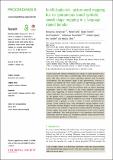Files in this item
Bo-NO-bouba-kiki : picture-word mapping but no spontaneous sound symbolic speech-shape mapping in a language trained bonobo
Item metadata
| dc.contributor.author | Margiotoudi, Konstantina | |
| dc.contributor.author | Bohn, Manuel | |
| dc.contributor.author | Schwob, Natalie | |
| dc.contributor.author | Taglialatela, Jared | |
| dc.contributor.author | Pulvermüller, Friedemann | |
| dc.contributor.author | Epping, Amanda | |
| dc.contributor.author | Schweller, Ken | |
| dc.contributor.author | Allritz, Matthias | |
| dc.date.accessioned | 2022-02-08T11:30:11Z | |
| dc.date.available | 2022-02-08T11:30:11Z | |
| dc.date.issued | 2022-02-09 | |
| dc.identifier | 277723383 | |
| dc.identifier | b4e252dc-bd83-45d9-a89b-9bd6ec13a30e | |
| dc.identifier | 35105236 | |
| dc.identifier | 000749623800012 | |
| dc.identifier | 85124059176 | |
| dc.identifier.citation | Margiotoudi , K , Bohn , M , Schwob , N , Taglialatela , J , Pulvermüller , F , Epping , A , Schweller , K & Allritz , M 2022 , ' Bo-NO-bouba-kiki : picture-word mapping but no spontaneous sound symbolic speech-shape mapping in a language trained bonobo ' , Proceedings of the Royal Society of London Series B: Biological Sciences , vol. 289 , no. 1968 , 20211717 . https://doi.org/10.1098/rspb.2021.1717 | en |
| dc.identifier.issn | 0962-8452 | |
| dc.identifier.other | Jisc: 8c3f85047a1b4ff6886c991264f04391 | |
| dc.identifier.other | publisher-id: rspb20211717 | |
| dc.identifier.uri | https://hdl.handle.net/10023/24821 | |
| dc.description | This work was supported by the Deutsche Forschungsgemeinschaft (DFG, German Research Foundation) under Germany's Excellence Strategy through EXC 2025/1 ‘Matters of Activity (MoA)’ and by the ‘The Sound of Meaning (SOM)’, Pu 97/22–1 and ‘Phonological Networks (PhoNet)’, Pu 97/25-1. K.M. was supported by the Berlin School of Mind and Brain, by the Onassis foundation, and by the Fyssen foundation. M.A. was supported by the European Research Council under the European Union's Seventh Framework Program (FP7/2007-2013)/ERC grant agreement no. 609819, SOMICS. | en |
| dc.description.abstract | Humans share the ability to intuitively map ‘sharp’ or ‘round’ pseudowords, such as ‘bouba’ versus ‘kiki’, to abstract edgy versus round shapes, respectively. This effect, known as sound symbolism, appears early in human development. The phylogenetic origin of this phenomenon, however, is unclear: are humans the only species capable of experiencing correspondences between speech sounds and shapes, or could similar effects be observed in other animals? Thus far, evidence from an implicit matching experiment failed to find evidence of this sound symbolic matching in great apes, suggesting its human uniqueness. However, explicit tests of sound symbolism have never been conducted with nonhuman great apes. In the present study, a language-competent bonobo completed a cross-modal matching-to-sample task in which he was asked to match spoken English words to pictures, as well as ‘sharp’ or ‘round’ pseudowords to shapes. Sound symbolic trials were interspersed among English words. The bonobo matched English words to pictures with high accuracy, but did not show any evidence of spontaneous sound symbolic matching. Our results suggest that speech exposure/comprehension alone cannot explain sound symbolism. This lends plausibility to the hypothesis that biological differences between human and nonhuman primates could account for the putative human specificity of this effect. | |
| dc.format.extent | 607829 | |
| dc.language.iso | eng | |
| dc.relation.ispartof | Proceedings of the Royal Society of London Series B: Biological Sciences | en |
| dc.subject | Neuroscience and cognition | en |
| dc.subject | Research articles | en |
| dc.subject | Sound symbolism | en |
| dc.subject | Language evolution | en |
| dc.subject | Kanzi | en |
| dc.subject | Bouba-kiki | en |
| dc.subject | QL Zoology | en |
| dc.subject | BF Psychology | en |
| dc.subject | DAS | en |
| dc.subject.lcc | QL | en |
| dc.subject.lcc | BF | en |
| dc.title | Bo-NO-bouba-kiki : picture-word mapping but no spontaneous sound symbolic speech-shape mapping in a language trained bonobo | en |
| dc.type | Journal article | en |
| dc.contributor.sponsor | European Research Council | en |
| dc.contributor.institution | University of St Andrews. Organic Semiconductor Centre | en |
| dc.contributor.institution | University of St Andrews. School of Psychology and Neuroscience | en |
| dc.identifier.doi | https://doi.org/10.1098/rspb.2021.1717 | |
| dc.description.status | Peer reviewed | en |
| dc.identifier.url | https://doi.org/10.6084/m9.figshare.18737487.v1 | en |
| dc.identifier.grantnumber | 609819 | en |
This item appears in the following Collection(s)
Items in the St Andrews Research Repository are protected by copyright, with all rights reserved, unless otherwise indicated.

